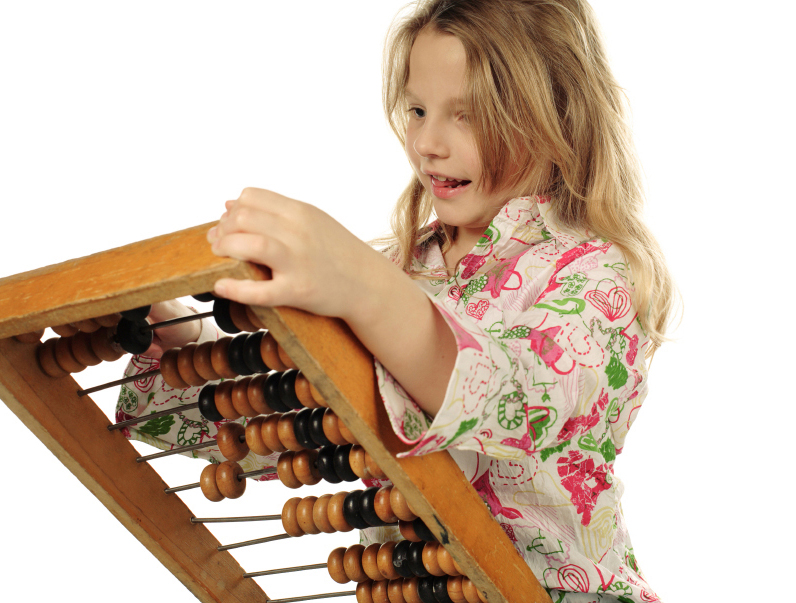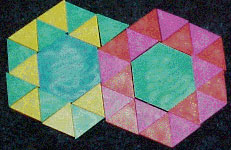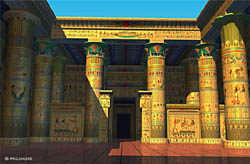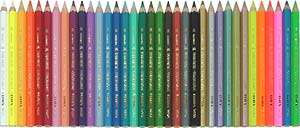

|
The Delights of Exploring Math With Your Child
Lillian Jones
Note: A number of excellent resources are referred to below, but none of them are ads.
The question of how to provide our children with a good math education often causes undue anxiety. With a clearer and more relaxed understanding of what it is that we're trying to accomplish, we can present it as just one more interesting part of life - one that anyone can easily explore and delight in.
Not everyone will become fascinated with math, any more than everyone will become fascinated with painting or creative writing - but anyone can at least become acquainted with the fun to be found in it, so that they can learn math as a useful and accessible tool rather than as a dull and exhausting set of mysterious processes understood only by people who are "good at math."

Math has always been a natural and necessary part of life. People throughout history have continually come upon wonderful discoveries and innovations for working with relationships, patterns, and quantities to solve problems or fulfill needs - but, unfortunately, we've managed to narrow our focus to those procedures, removed from the patterns being navigated by them.
Lancelot Hogben was a professor of medical statistics at Britain's University of Birmingham when he wrote a popular book called Mathematics for the Million: How to Master the Magic of Numbers, first published in England in 1937 and revised up until 1967. Albert Einstein said of the book, "It makes alive the contents of the elements of mathematics." Hogben once commented:"The best therapy for emotional blocks to math is the realization that the human race took centuries or millennia to see through the mist of difficulties and paradoxes which instructors now invite us to solve in a few minutes."
I wasn't even aware of his feelings on that many years ago when reading his wonderful children's book to my young son - The Wonderful World of Mathematics - but it was exactly my reaction at the time. See the review on it a bit further down this page.
Professor Emeritus Michael Butler, in a foreword to the children's math books, Patterns in Arithmetic, by Suki Glenn and Susan Carpenter, recalls his early exploration of new ways that math can be taught:
"Years ago I was a young professor at UC Irvine, and although I had long been fascinated by the act of learning, this was my first teaching job. Among other things I taught mathematics. The experience was immensely rewarding but unsettling. I thought of math as beautiful, richly ordered, and fun. Most of my students in those required courses appeared to think of it, at least at first, as arbitrary, impenetrable, incoherent, and dull; some of them found it scary.

A few students did not - cheerfully pushing and pulling at a formula, for instance, and asking: 'What would happen if this part of the denominator were in the numerator? What would happen if I reversed this and that part? What would happen if I made this piece very large or very small? What would be a simpler form or a more general form of the expression?' They engaged in this systematic play for the fun of it, but their reinventing or recasting of the material of mathematics also helped them see why something was the way it was; it helped them understand. In fact, the students I started listening to each seemed to carry with them a kind of 'understanding kit.' They had an expectation that math would make sense; they knew when a particular expression or idea did not yet make sense to them, and when it did; and they had developed skills and stamina for getting from the first state to the second, and the habit of doing so. The math they came to know in this way, they owned.
These happy few were regarded by the others (and by most of my colleagues) as having a peculiar knack. There was no shame in not having it; that was just the luck of the genetic draw. Or did the attitude of the rest of the class toward math have to do with the way they had been educated? Their reports of their pre-college math study matched what I found when I started visiting schools, especially elementary schools, and reading texts of that era: my students had been spending most of their time memorizing calculation recipes and learning to run them more or, often, less well.
But that wasn't at all what the kind of people who had discovered the math did. Mathematicians look for and find patterns in formal objects, extend them, seek counter-examples, figure out why the patterns work, and then, finally, publish an account of one way that they work. The last is the public part, but the rest is what they do. Almost none of my undergraduate students seemed to have had much experience with that. There was an odd disjunction between what practitioners did and what schools asked students to do, a disjunction that was deeper and odder the more you looked at it. It was as though we had plucked the fruit "mathematics" for use in schools, peeled it, and fed students the rind instead of the flesh."
Suki Glenn, is the one of the inspiring authors of the Pattern Press children's math books - a program that uses a multi sensory approach developed in an experimental education program called The Farm School at U.C. Irvine. In the Pattern Press web site, she explains her philosophy of teaching children to think like mathematicians:
"What do mathematicians do? They are good at constructing models, looking for number patterns, and using those patterns to develop reliable procedures for solving problems. The procedures we all use to add, subtract, multiply or divide were created by mathematicians who generalized a physical reality to an abstract mathematical formula. They invent short cuts and easy recording systems (like place value) and then teach them to all of us.

The skills of a mathematician can be developed in children by allowing them to use manipulatives to build models of the physical reality of addition, subtraction, or whatever subject with which they find and use patterns, and then create their own procedures for doing arithmetic operations. If children are given the chance to discover the procedures instead of being told how to do it and then drilling it in, you will find the results superior, the learning more of an adventure. You will have experiences of delight as your young mathematicians surprise you with methods and models you have never seen."
To begin finding inspiring ideas for learning about the enjoyment of math:
Read the online article A Travel Excursion of the Mind, an excerpt from David Albert's excellent book, Homeschooling and the Voyage of Self-Discovery: A Journey of Original Seeking. He provides an enlightening and humorous look at effective ways to lead kids into the appreciation of math, and suggests creative ways to make math an important and enjoyable part of life.
Another enlightening article of David Albert's is Just Do the Math! - an excerpt from his book, Have Fun. Learn Stuff, Grow! Homeschooling and the Curriculum of Love. It explains how math can be mastered in an astoundingly short time when the time and conditions are right.Read Sue Heavenrich's online article, Crazy for Calculating! Making Math Fun!, a description of how she made math fun for her kids in spite of her own previous math phobia.
Check out Pam Sorooshian's wonderful math blog - Joyful Math! It includes teaching tips, insights, inspiration, fun games and interesting math activities. Her love of math is infectious and can't help but broaden, enlighten, and lighten anyone's attitude toward math.
One really fun and fascinating way of understanding and appreciating math is to look back at its beginnings - to the reasons and ways in which people have developed math:
The Wonderful World of Mathematics, by Lancelot Hogben is a beautiful children's book that has been around since 1955. I think this observation of Hogben's, also quoted above, is well worth repeating:
"The best therapy for emotional blocks to math is the realization that the human race took centuries or millennia to see through the mist of difficulties and paradoxes which instructors now invite us to solve in a few minutes."
This is a picture book that tells the stories of how simple systems of math were first developed for practical, everyday reasons. You can even use common materials from around the house to reproduce the processes that people in early civilizations used. It's pretty amazing to a child to realize that he already knows more about some of these processes than some of the brightest adult minds once did. This is the kind of thing that makes the imagination soar - and it was none other than Albert Einstein who commented that "Imagination is more important than knowledge." This book is sometimes hard to find, but it's in quite a few libraries, so ask your librarian if they can get it for you.
These are some very interesting web pages on math history:

Helpful online math resources:
Take a look in BestHomeschooling.org's list of annotated links to good math pages: Go Figure! The Fascinating World of Mathematics. Here are just a couple of examples:
Mathematics Lessons that Are Fun! Fun! Fun! - Interactive math activities for kids from Cynthia Lanius of Rice University's math department - activities like "Let's Graph," "Who Wants a Pizza?" (fractions), "Mathematics of Cartography," "Calendar Fun: It's Algebra," "A Fractal Geometry Unit," "Pattern Block Geometry," and many more!
Count on! - An extraordinary, unusually inventive and colorful site of math adventures, games, tricks, mathszines, resources, links, and more for all ages. It's well worth taking the time to explore every nook and cranny of this site.
A few of the many good books for learning math while discovering the fun in it:
In FUN-Books catalog's Mathematics page, you can find a delightful and amazing assortment of books for making math fun and interesting - everything from books on math & music, math patterns, games, the math adventures of SIr Cumference, grocery cart math, hands-on projects, understanding algebra, and others too numerous to list.
You might be thinking "This is all well and good, but what can I do to teach my kids math? I'm the sort of person who needs a structured and methodical plan, and I don't know where to begin! What about math texts and workbooks?
You might be surprised how quickly this anxiety starts to lift as you begin to explore some of these resources and activities with your kids. Becoming comfortable with math might take a little bit of time - but it will be time well spent. Kids simply cannot "get behind" as fast as you might imagine - and the quality of their learning will be tremendously affected by your taking time to explore some of the creative resources and advice that are available.
There are some nice math texts around - it's just good to be aware that texts and workbooks are not the Be-all or End-all in learning math. Most seasoned homeschoolers will advise you to proceed very slowly and carefully in picking out materials that are a good fit for your child. A textbook or workbook that doesn't fit with your child's learning style or interest, can be deadening - especially if used before you and your child have a good grasp of what math really is and the enjoyment that can be found in it. Here are a few good sources to consider for some of the best materials:

Your child might really enjoy using colored pencils for math. I knew an occupational therapist who did sensory integration in public schools, and she commented that one of the things she really liked about Waldorf schools is their use of color. The colored pencils provide a certain kind of multi sensory delight that aids in the learning process, and greatly enhances the kineshthetic and visual pleasure of writing. The large, waxy, Lyra ones are wonderful. They can now be found on a number of web sites - try Waldorf Supplies.
Learning and the all-important ~joy~ of learning happen in a much deeper way when learning is not thought of as a series lessons so much as an ongoing part of life.The joy of learning is what will create a lifelong learner who has the curiosity, ability, and confidence to easily learn about anything life has to offer - and in the shorter term, real learning simply works a lot better when the learner is engaged from the inside rather than from external pressures or coaxing.
Albert Einstein, someone who certainly had a very special interest in learning, said:
"It is, in fact, nothing short of a miracle that the modern methods of instruction have not yet entirely strangled the holy curiosity of inquiry; for this delicate little plant, aside from stimulation, stands mainly in need of freedom; without this it goes to rack and ruin without fail. It is a very grave mistake to think that the engagement of seeing and searching can be promoted by means of coercion and a sense of duty."Cynics who have been indoctrinated into traditional attitudes about education (we've all been there) will often say that "Learning doesn't have to be 'fun' - kids just need to be made to do the work to learn what they need to know." This is simply not true - learning is not about "work." Take a look at some of the things these widely respected researchers and educational theory authors have to say on the subject:
Frank Smith: In the Amazon.com description of his book, The Book of Learning and Forgetting, you can click on the words "Look inside this book" under the picture of the book cover, and get a sense of what you can learn from this amazing book, considered life-changing by a number of people who have read it. Another of his books, The Glass Wall: Why Mathematics Can Seem Difficult, is a fascinating read for discovering how math really works and how it can be made accessible.
Alfie Kohn: In his online article, Students Don't "Work" - They Learn!, Kohn offers thought provoking arguments against prevailing educational assumptions. More good articles and descriptions of his popular books can be found in Alfie Kohn's web site.
Dr. Thomas Armstrong: Dr. Armstrong has written a number of popular books on the subject of learning, and has some wonderful articles in his web site: Articles about learning, by Dr. Thomas Armstrong.
These are just a few of the ways in which a child can learn a number of mathematical concepts in a natural way through everyday activities:
Cooking and baking call for the use of measurements, counting, timing, estimating, dividing or multiplying a recipe, cutting or dividing the cooked goods, portioning, etc., all requiring the obvious use of math.
Crafts and building projects use mathematical thinking in measurement, calculations and estimations, and arithmetic. Take a look in the juvenile non-fiction section of the library for books on all the fun projects you can make with kids.
Observing and participating with the use of money in the course of shopping, both in grocery stores and other places, offers a valuable opportunity to happily engage kids in comparing prices, using coupons, estimating, weighing, and using mental arithmetic to estimate the cost of multiple items, and so forth. Teachers in schools often have to refer to expensive specialized educational materials in order to recreate the activities you can do with your kids in real life.
Everyday activities around the house - doing repairs, taking measurements, hanging pictures or shelves, setting the table, and so forth, often call for simple mathematical processes.
Sewing projects and quilting: There are lots of patterns today for fun and useful crafts and decorating ideas - and these activities require ongoing mathematical thinking about relationships. You might be surprised at the patterns and ideas to be found in the fabric/craft store.
Using maps: Kids love maps and can help keep track of mileage and comparisons of routes, as well as help estimate fuel and other costs on trips, etc. Again, these activities are most successful when suggested casually and positively in the natural course of events rather than presented as lessons.
In all sorts of hobbies and other special interests - math turns up everywhere in many forms.
Try "playing store" - You can use milk, cereal, and other food item containers to make a supply of play goods for a fun little store - and there are great toy cash registers to add to the fun.
You are also using mathematical thinking when you play around with any of these:

Tangrams
Pattern Blocks
Cuisenaire Rods
Real U.S. currency, both coins and paper - a fun and practical way to learn about arithmetic, percents, fractions, and more...
Legos are a natural way of noticing math patterns - but it would be a mistake to try to make Lego play into structured "lessons."
Educational software can be a lot of fun and reinforce mathematical thinking:

The Incredible Machine
Return of the Incredible Machine - Contraptions
The Incredible Machine - Even More Contraptions
The Logical Journey of the Zoombinis
Zoombinis Mountain Rescue
The Number Devil
You can waste a lot of money on mediocre educational software - so it's wise to read reviews and ask around. These are a few good places to read about educational software:
Superkids Educational Software Reviews
MultiMedia & Internet@Schools Magazine
A few sources for buying educational software:
Games! - As casual and ongoing fun activities, games can be a very effective way for learning to take place. The use of mathematical thinking is a common feature of many card and board games. This article in the Ask Dr. Math website explains more: Math in Card Games.
Try incorporating some of these popular games into your routine. You can type any of the names into Ask Jeeves or Goggle for more details on any of them that you might not be familiar with - but be sure to also type in the word "game" after a game's name to narrow the search down!
Some good games for practicing math skills:
With all this to explore, there's not much time to worry about math anxieties, because you'll be so busy having fun and exploring math with your children!
Copyright 2005 Lillian Jones
 |
Back to BestHomeschooling Home |
Copyright 2004 BestHomeschooling.org. All rights reserved.
Please feel free to link to this site, BestHomeschooling. org, but do not
copy material and/or reproduce or distribute it in any way without
permission. Authors of articles retain the rights to their own
articles which may not be reproduced without their permission. |